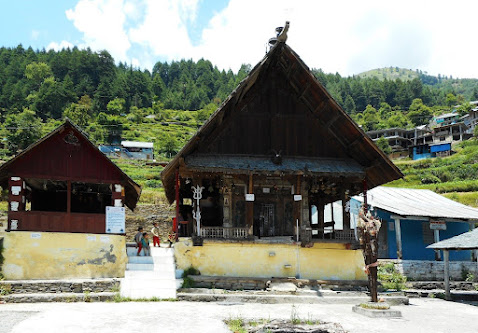KALI - THE FIERCE WARRIOR
Site name: Devi Kothi Temple, Chamba, Himachal Pradesh
Article written by: Shreeya Rawat
KALI
– THE FIERCE WARRIOR
The temple of Devi Kothi,
dedicated to Goddess Chamunda, is situated in the Chamba district of Himachal
Pradesh. It was constructed in 1754 C.E. by Raja Umed Singh, a strong believer
in the Shakti cult. The wooden temple comprises architectural features such as
a pent roof, an inner cella or the garbhagriha along with the pradakshina path.
The outer walls of the garbhagriha (sanctum sanctorum) are painted with some
interesting murals in tempera technique, wherein the pigments are mixed with a
binding medium and used on a dry plaster. The temple is embellished with
woodcarvings on the wooden ceilings and pillars, which has an influence of
Mughal elements.
The paintings of this
temple belong to Chamba (Pahari) School of painting which is based on Rajput
style having a Mughal influence. Artist Laharu, one of the famous painters of Chamba
was commissioned to work on these paintings by Raja Umed Singh (1748-64).
The painted panels on the
exterior walls of the garbhagriha
glorify the victories of Goddess Durga over the demons, her valour and her
various manifestations. Besides, there are also some paintings of Lord Krishna,
his fight with the demons and his love for Radha. Other themes have been taken
from the famous epics of Ramayana and Mahabharata.
“सर्वमङ्गलमाङ्गल्ये शिवे सर्वार्थसाधिके । शरण्ये त्र्यम्बके गौरि नारायणि नमोस्तुते ॥
ॐ जयंती मंगला काली भद्रकाली कपालिनी । दुर्गा क्षमा शिवा धात्री स्वाहा स्वधा नमोस्तुते
॥“

The Tridevas along with Lord Indra and Sage Narada approaching Goddess Durga for help
One of the scenes on the panel illustrates the famous
battle of Kali and Raktabija, an episode taken from the Hindu religious text of
Devi Mahatmya, part of Markandeya Purana. The demons led by Raktabija
overthrew Lord Indra, the god of heaven, gained control over his empire and
attempted to invade and conquer the earth. Disturbed by their rising power, the
tridents along with Lord Indra and Sage Narada approached to Goddess Durga for
help, who in return, agreed to help the gods in fighting with the demons.
Towards the right-hand
side of the panel, Goddess Durga is shown clad in a red and white saree,
adorned with a crown and necklace, and slaying the demons. She is sitting on a
tiger and holding a trishul, dagger, sword and a bowl in her hands.
Raktabija was a demon who
was blessed with a boon from Lord Brahma to produce more demons every time a
drop of his blood fell on the ground. In a short span of time, thousands of
Raktabija covered the battlefield and it became difficult for the gods to slay
them. Shakti took various forms to kill the demon, but the army only grew. Goddess
Kali then sprang from the forehead of Goddess Durga and emerged in the
battlefield. In the painting, Kali is portrayed as wearing scanty clothes, a
garland of human skulls and holding a sword and a bowl in her hands. The
goddess is shown stretching her huge tongue and devouring all the blood
ensuring that not a drop fell on the ground, thus eventually killing Raktabija.
Another painting on the same panel depicts the incident of the battle
scene between Goddess Durga and Mahishasura. Goddess Katyayani is shown
striking at the demon with her trishul and
sword, after which she became to be known as Mahishasuramardini.
With age, these paintings are suffering structural damage such as cracks
on the painted walls and there is fading of paint layer which needs to be
conserved. Recently, according to sources, the temple was being re-constructed
by contractors without any advice from experts who were concretizing the temple
building along with the paintings. Malvika Pathania, coordinator at INTACH, is
taking an initiative to restore the damaged building. The RCC work on the
temple was stopped and the RCC pillar around the temple will be removed. The
temple will be renovated using wood and local rock in a traditional manner.
REFERENCES
Online
- https://www.sahapedia.org/devi-kothi-temple-chamba-art-and-influences
- https://www.sahapedia.org/laharu-and-mid-eighteenth-century-chamba-painting
- https://www.artofliving.org/navratri/durga-saptshati-story-7-the-end-raktabeeja









Comments
Post a Comment